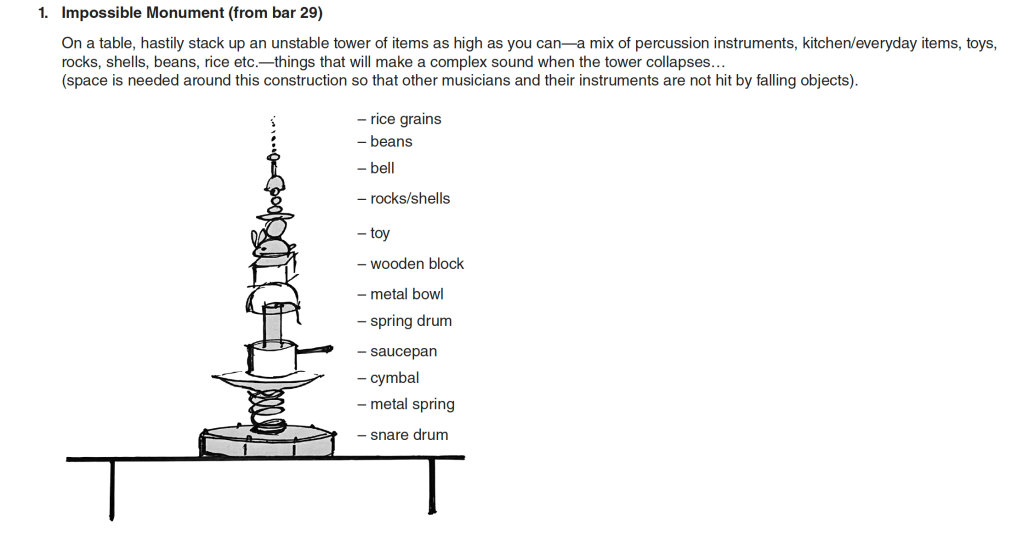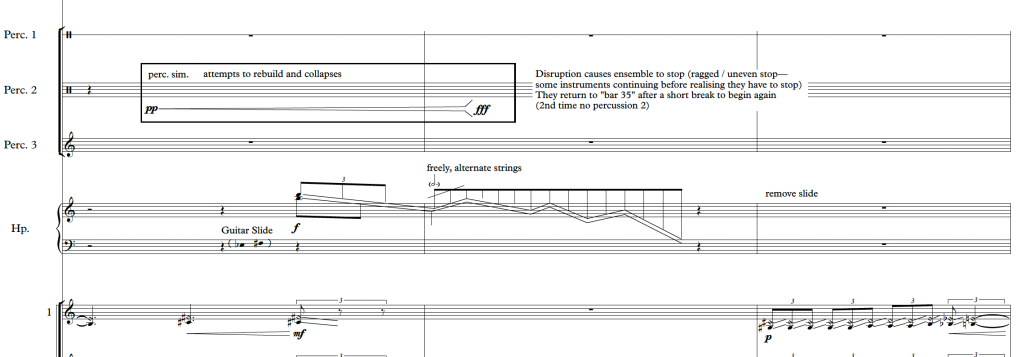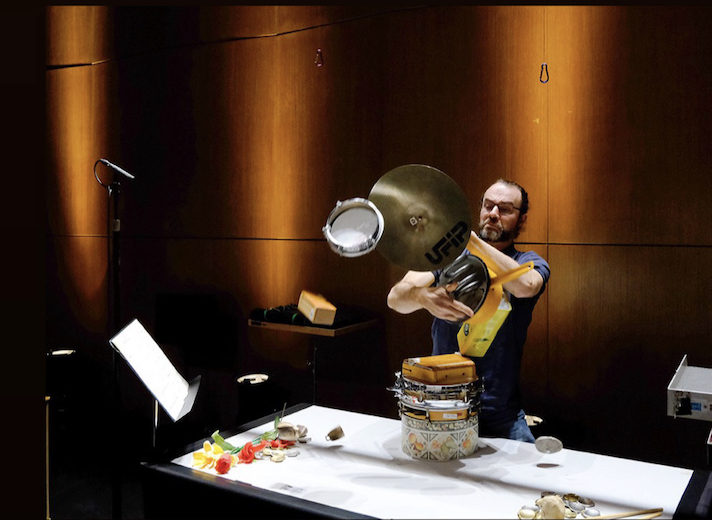I recently gave a keynote address for the ARTikulationen conference ‘Researching Across’ at Kunstuniversität in Graz and discussed two recent works: The Tailor of Time (2023) and Multispecies Knots of Ethical Time (2023). My talk focussed on some ideas or ‘thought experiments’ around multiplicity; on some perspectives, perceptions and experiences which resist notions of the bounded individual self. The following text comes from the first part of that talk.
Underpinning these recent works is an ongoing engagement with ecological thinking – the idea of a profound dynamic, interconnected entanglement between all things. I ask: ‘what are ways to prioritise collaborative processes to make space for unforeseen, emergent effects’ and I’m increasingly asking, ‘what does it mean to collaborate with the more-than-human?’ What happens when you take seriously the notion of the sentiency or the living nature of not just fellow creatures such as animals, birds, insects or plants and maybe a river and its life worlds? What happens when we take this further? for clearly, the more-than-human extends further: to instruments, technologies, notations, to music itself. In what ways are these also living and sentient?
A basic definition of sentience is the ‘capacity for sensation or feeling’, ie: a form of consciousness that living things have.
In what way can we say that non-human things have sentience and what does that open up for ways of making art?
The Tailor of Time was premiered on 25 September 2023 by the Ensemble Intercontemporain at Festival Musica in Strasbourg. The work was commissioned with funding assistance from the French Ministry of Culture and the DRAC Grand-Est, the Ensemble Intercontemporain, the Festival d’Automne à Paris and the Festival Musica Strasbourg and is scored for solo harp, solo oboe and ensemble of 28 musicians lasting about 28 minutes.
The title of the work comes from some lines from the Mathnawi by 13th C Persian Sufi mystic, Jalāl al-Dīn Muḥammad Rūmī or Rumi (lines translated by Coleman Barks):
I have known pigeons who fly in a nowhere,
and birds that eat grainlessness,
and tailors who sew beautiful clothes
by tearing them to pieces.
In another verse, Rumi says:
The tailor of time has never sewn a shirt for any man without tearing it to pieces.
Rumi’s poetry is suffused with paradoxical images of making and unmaking, absence and presence. The way he weaves ideas together is very much part of the Sufi ethos of teaching through stories and images of humble craftsmanship and everyday things to point to subtle messages of spiritual alchemy and transformation. His poetry often revolves around images of longing and erotic desire, bewilderment and annihilation in the face of Divine love. The Sufi poetic repertoire provides a clue to the two soloists in the work: the oboe and harp. Again and again in Rumi’s work, we find references to the crying of the ‘reed flute’ as a figure for the way that Divine breath comes through us into the world, and to the plucked strings of the lute as a symbol for the spiritual longing of the Lover’s heart strings.
In Rumi’s lines, Time is a ‘tailor’ continually tearing, altering, molding us and the world.
For me, this resonates with my compositional questions around time, temporality and the use of recurrence, repetition and interpolation as musical tools.
Time tears us but how does one tear time? How does one tie ‘knots’ in time, sew ‘pleats’ or ‘pockets’ in time and not only disrupt but rip up, create rifts in, and erode the materiality of time?
One way I do this in the piece is to physicalise a time process.
Within the ensemble, one of the percussionists embodies a kind of crazy/absurd/paradoxical/Sufi-spiritual state and has a number of ‘instruction pieces’ in which activities are described that also result in sounds as the musician moves objects and interacts with them.
The first of these instructions Is ‘build an impossible monument’ by stacking up various household objects, instruments, rocks…
Ex.1. Score instruction, The Tailor of Time, ‘impossible monument‘ (score published by Ricordi Berlin)

Ex. 2 Video, Samuel Favre performs the percussion part in the ‘impossible monument’ section, The Tailor of Time, bars 29-40 (rehearsal footage, Ensemble Intercontemporain conducted by Pierre Bleuse, with thanks to Luc Hossepied)
It’s a game of attempts and failure where the percussionist’s activity tears apart the activity of the ensemble of musicians. The ensemble begins again and are interrupted; they backtrack to another earlier point to restart and are again disrupted.
This figure of the teetering, impossible tower being built up and falling is then multiplied compositionally in various ways through types of repetition where the music is tracking back, dropping things, inserting things. A large part of the compositional research revolved around looking for different ways of expressing figures or moments of temporal disruption and alteration.
The work begins with a simple fold. A kind of pendulum movement that opens up and then folds back down. 2 French horns course up and down the harmonic series; their movement is a bit ungainly (like heavy swans); it takes a bit of effort to swing up and there’s a kind of inertia, a pause or hesitation before each up and down movement. I orchestrate this: at times focussing on the movement, at others on the suspension and with each fold or swing, the music gains more momentum.
What was a simple fold in material and fold in time at the beginning is subjected to increasingly seismic forces – you hear and see the exertion of the percussionist and the objects of the tower buckling and crumpling. There’s literal collapse and at the same time a musicalized world of time collapse where the forward movement loses traction and one has to keep beginning again. I’ve scripted this through a diagram and text instructions in the percussion part. The following score example shows the third disruption:
Ex. 3 The Tailor of Time score excerpt, bars 36-37

I also explore ways of using tools of music notation to make these folds in time.
Ex. 4 The Tailor of Time, bars 50-53 of score showing interlaced repeats

I use repeat brackets to isolate a segment of music or a segment of time, and interweave it with other succeeding segments The coloured annotations, for instance the red lines, show how one reads or travels through the music until one meets an end bracket; one then tracks back to the corresponding bracket which is not at the beginning of the bar. What’s more unusual about this procedure is that instead of taking a chunk of music and repeating it wholesale to create a loop which is what one might normally do with a repeat bar, I interlace the repeats so that one has an incomplete reading of the material. The second loop is blue and again only catches part of the same musical material when it goes back, before going on. The green arrows show a knot moving around a triplet figure three times before moving on.
These interlaced repeats are a way of increasing the complexity of the folds to create a pleating of time or knotting of time. For further discussion about these time loops and notation see my article, Lim, L. (2020) An Ecology of Time Traces in Extinction Events and Dawn Chorus. in Contemporary Music Review, Vol. 39, No. 5. 544-563.
Of course one can easily work with this process through electronic means – it’s the basis of sampling and glitch music — but what’s interesting for me with the music notation is the way one can lift out a slice of time and play with the degree of slippage through visual means. One can fold something and turn a corner in a very fine-tuned way and it becomes very interactive. I play with the degree with which something is folded over or pulled across something else. It feels very physical. One can make judgements about how the folds impact the way the music is flowing and respond to the emergent rhythmic effects that result. It’s a very lively situation and I found that as I kept pleating and knotting the material, as well as more assymmetrical kinds of shapes, I ended up with fine layers of pulsation of things rippling up and down in an articulated scanning of the opening overtone material.
Here’s an excerpt of the recording of the work from about two-thirds of the way through the piece showing some of the kind of textilic results from these repetitions and folds.
Ex. 5 audio excerpt, The Tailor of Time, bars 218-259 (1’40)
Paradox
So let’s try and stay in Rumi’s paradoxical space…
Paradox arises when there’s conflict or contradiction of world views. But paradox is not just a contradiction of logic between one set of realities and our expectations of what reality should be – it’s more than a structural gap, or a dissonance between things that don’t add up. Paradox is a more unstable or activated state because it invites you to try and resolve that dissonance; and you can’t do that by staying in the same position, the same vantage point of your ‘reality’; this is what can lead to a paradigm shift. It’s why it’s a favoured form in art and philosophy and of course also spiritual teaching, whether in Sufi thought or Zen Buddhism. It offers a chance to slow down, it compels you to step away from that more rigid investment in what things mean and notice the ways in which one’s own positioning, or subjectivity co-creates so-called objective reality. The teaching occurs through the shift in ourselves as much as what’s seemingly ‘out there’.
Here’s the thought experiment:
I experience working with notation as a collaboration.
As I work with this more-than-human collaborative partner, it starts to speak back to me.
I begin to experience notation as something living, as sentient.
So, in the paradox, something which looks like a static code from one vantage point, from another, starts to have a life of its own. It starts to have a kind of agency; it starts to do things.
What is this creative state where notation starts to be sentient?
It’s an ecstatic state, an expanded state where things come alive. I make a move or decision but at the same time it feels like the notation and the music tells me what to do; it pushes back at me; it reveals itself.
Actually this is not just something I experience as a composer.
I think the sentiency of notation is something that performers can easily experience. This absolutely goes against the grain of the kind of Western classical training where notation is regarded as the sacred word of the composer where the task is to faithfully reproduce ‘what’s there on the page’. To me that’s a rather parsimonious relationship to notation.
If you shift your perspective you can see another reality: where the notation is moulding the performer and their body in incredibly intricate ways. There’s a sensual rhythmic, ergonomic relationship between the notation, the sound, and the choreography of the body to achieve those sounds, as well as the many, many aspects of the musical and cultural codes that are not expressed in the notation at all but are understood as tacit knowledge, as performance practice. And then there are all the involuntary constraints, accidents and compensatory moves of the body with its lines of force, curvatures, tensions, torsions, which also have life, which also speak…
What levels of sensory abundance could be unlocked for the performer if they engage with the sentiency of notation?
I’ve tried to model the usefulness of paradox here. Rather than definitively coming down on one side or the other of locking in definitions and meaning, what if one were to keep up in play the things that inhabit different worldviews? One can argue things into lifelessness or one can enter into a weaving, rhythmic multi-modal sensory relation where what one does is continuous with a wider living world.
To hear the full work, there’s a broadcast from France Musique (starts 38:20) of the Strasbourg premiere.
The next performance of The Tailor of Time takes place on 4 November 2023 at the Cité de la Musique as part of Festival d’Automne à Paris in a program with my work Spirit Weapons 1 & 2 (1999) for solo ‘cello; contrabass clarinet & 3 percussion (also originally commissioned by the EIC) and Enno Poppe’s Blumen (2023). The Ensemble Intercontemporain is conducted by Enno Poppe with soloists Valeria Kafelnikov (harp) and Philippe Grauvogel (oboe, oboe d’amore & bass oboe).
*update: there’s also a short doco on the work on Youtube
